It is often asked: what is the optimal chain length for a bicycle with derailleurs? Should a new chain be shortened and how much? That is answered in this post. For single speed bicycles (or bikes with internal gear hubs), see: Determining optimal single speed chain length.
Table Of Contents (T.O.C.):
- Bicycle drive chain length
- The importance of determining the correct chain length
- Chain length sizing for bicycles with derailleurs
- Rear derailleur chain wrap capacity not big enough
- Shortening and re-connecting bike chains
TL/DR
Here, I explain:
- Why it’s important to cut your chain to the optimal length?
- How to measure that (before cutting 🙂 ) for 1-X vs double and triple crank drivetrains?
- What can you do if your chain is too long for your RD cage to handle?
1. Bicycle drive chain length
A new bicycle chain usually comes with 116 links. This is long enough for the biggest chainrings and for most distances of rear wheel from front chainrings. So for optimal length a new chain is usually shortened from the 116 links that come in the box. In rare occasions – touring frames for example, with extremely long chainstays, 116 links might not be long enough, so a few links off another new chain need to be added to reach optimal chain length.
2. The importance of determining the correct chain length
Too long chain will increase risk of chain dropping, while too short chain puts too much stress on the drivetrain, or can damage it, if it can be put and closed over the chainrings in the first place. Chain that is too short can also damage rear derailleur.
3. Chain length sizing for bicycles with derailleurs
There are several methods for getting the chain at the correct length. The method explained here is certain to result in a chain long enough not to cause any drivetrain damage. The method is called “big-big”.
In order to make absolutely sure the chain is long enough, it should be put around the biggest chainring in the front, the biggest sprocket at the rear and then add one more inch, i.e. one link because of the derailleur (one link consists of a pair of outer and inner plates, as shown in the picture below – it is often referred to as “two links”). When measuring, the chain is not put through the rear derailleur, the derailleur is moved so it doesn’t get in the way.
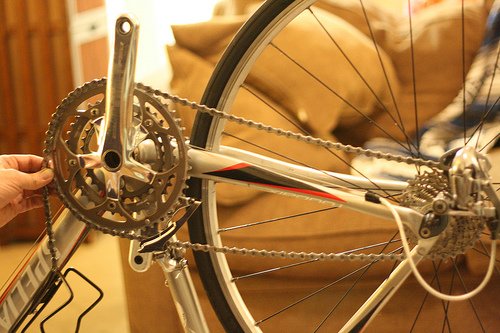
This makes the chain one inch longer to accommodate the rear derailleur.
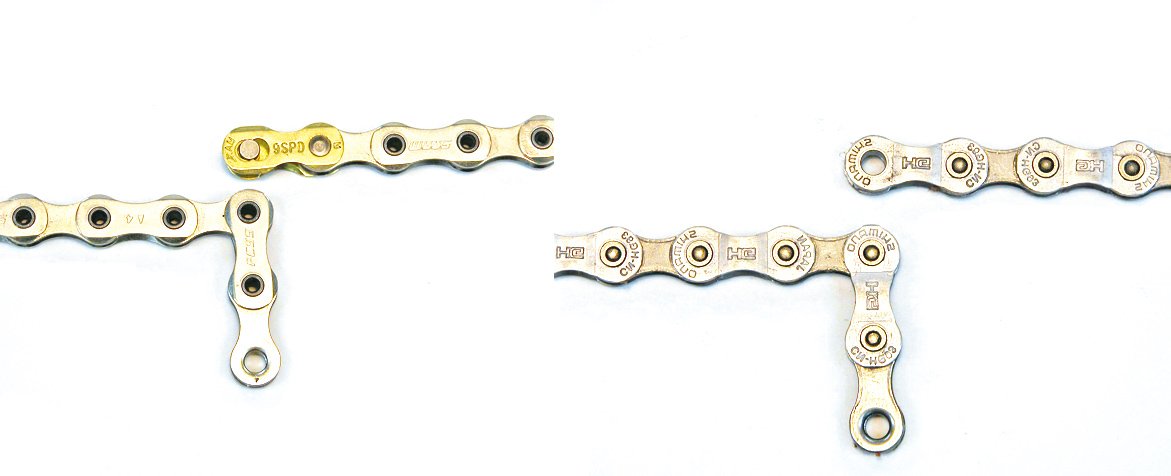
On the left is a chain with a quick link, while on the right is a “standard” chain using a connecting pin.
For bicycles with rear suspension, the suspension should be totally bottomed – compressed when using this method. See the position of travel where the rear wheel is furthest away from the cranks. To achieve this with air shocks just let the air out, while for ones with spring one has to remove the shock, remove the spring, then put the shock back. Simpler, though not 100% reliable method is adding one extra pair of inner and outer links to the length determined by the method explained below.
With modern, more and more popular systems that have one chainring in the front and multiple chainrings in the back (“1x” systems), the optimal length is achieved when adding two extra links, instead of just one, after wrapping the chain around the only front chainring and the largest rear sprocket.
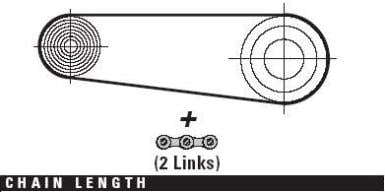
For bicycles that have more than one front chainring, i.e. those with a front derailleur.
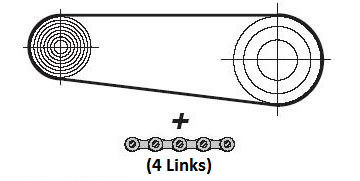
For bicycles with only one front chainring, i.e. without a front derailleur.
(see pros and cons of 1x drivetrains)
That’s all. A simple method. What to look out for?
Help BikeGremlin
stay online & independent
This website is educational, free, objective, and not commercial
(sponsors don’t enjoy paying if you mention all the product downsides that you notice 🙂 ).
How much does a WordPress website cost?
If you find this site to be good and helpful,
and if $5 per month is what you can afford to set aside,
please consider supporting my work with a Patreon donation:
4. Rear derailleur chain wrap capacity not big enough
Rear derailleur chain wrap capacity may not be big enough.
The explanation of what RD capacity is can be found under “Derailleur capacity” in this page: Rear derailleur.
This results in a situation that in a small-small chainring combination, the chain is too slack and can even fall off chainrings on bumpy roads.


Bottom part of the chain is rubbing the top RD jockey wheel.
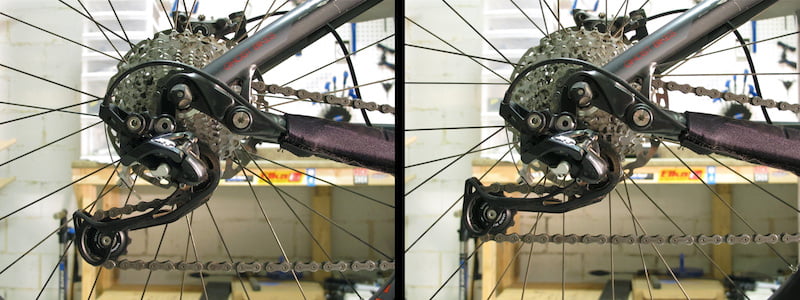
Chain to the right is still a bit too long for the RD wrap capacity, just not as extreme as in the two pictures above.
RD cage is parallel to the ground, making it hard for the RD to tighten the chain strongly enough.
This problem can be solved in three ways:
- Getting a rear derailleur with a longer cage.
- Avoiding smallest few sprockets at the cassette when the chain is on the smallest chainring in the front.
- Shortening the chain.
The third method is potentially dangerous, because in a big-big combination the chain will no longer be long enough. This can result in tearing the rear derailleur when changing to the biggest sprocket at the rear if the big chainring is used in the front.
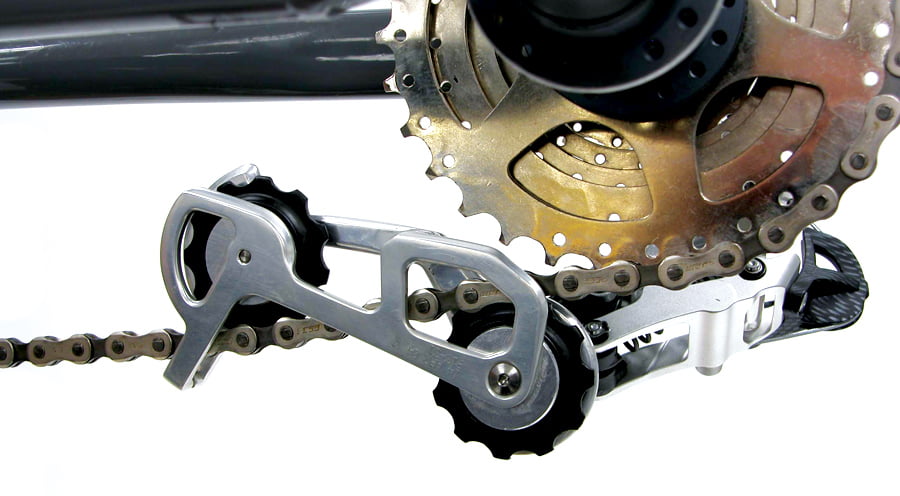
It managed to shift into big-big combo, but there is almost no bend at the derailleur jockey wheels.
Small-small and big-big combinations are combinations to avoid anyway, because the chain is cross-chained in those combos, the same gear ratio can be achieved with a middle-middle combination easily. Still, it can happen that in a moment of lesser caution, one does shift into one of those combinations. That is why, if method 1 is not possible for any reason (financial or some other), it is safer to use method 2 than method 3.
5. Shortening and re-connecting bike chains
For this, I’ve made a video demonstration:
Related post – How to lubricate a bicycle chain:

The existing comments posted under this article (questions and answers) have been moved to this BikeGremlin forum thread:
https://www.bikegremlin.net/threads/chain-length-sizing-for-bicycles-with-derailleurs-article-comments.124/


Ok understood. I’m pretty aware of my gears and so pretty much never shift into small small so going the safe route or installing a 11-40 cassette seems the best option to me. Thanks for taking so much time out of your (days) for answering my question. Hopefully other readers learn something as well.
And just to make sure: a MTB cassette plus a rear MTB derailleur with a MTB rear derailleur shifter plus a front road derailleur with the appropriate road (flat bar) shifter works fine right? There is no chainline problem there? As far as I understand the chainline only has to match between crankset and FD.
Hi Nic,
Having your front chainrings too far out or too close inwards can prevent the FD from shifting onto a chainring.
When that is the case, chainline is usually also incorrect. I.e. when you set the chainrings to match the rear sprockets’ chainline, FD should be fine (unless it’s an exotic frame/setup).
For more details, see my article about bicycle chainline.
As far as shifting goes, the setup you noted should be OK (as long as the derailleurs match their shifters and as long as shifters match their chainrings/cassettes).
You have a new Patreon supporter;)
I will reply on the chainline entry you linked to above because this is a bit off topic for this page.
Hi, there is not much information on how to size for a 20 inch wheel mini velo.
For a front chainring 53, rear casette 11-32 setup. Do i add two or four links when measuring the big/big?
Hi,
If it’s a one-by (1x), I’d size the chain as explained for the one-by drivetrains, i.e. add 2 inches (i.e. 2 pairs of inner+outer links, i.e. 4 chain pins).
Hi,
What a great resource! Thank you.
My question regards swapping front chainrings on a 1 X system. I want to be able to run two different sized front chainrings that I can swap out depending on the terrain.
I run an eThirteen 9 to 50 cassette and want to be able to swap out a Wolf Tooth Camo 38 front chainring to a Wolf Tooth Camo 28 front chainring.
Chain length calculators estimate that with my 450cms chainstays, the length of my chain with the 38 front chainring will be 148cms (116 links) but 142cms (111 links) with the 28 front chainring.
Is this difference going to be OK for the SRAM 1 x X01 Rear Derailleur to handle? Or am I going to experience the chain dropping or rubbing the chainstay, when I switch to the 28 front chainring?
Many thanks in advance.
Hi Carlos,
To answer that question, we need two pieces of information:
1) The total chain wrap capacity needed (tooth count).
2) The chain wrap capacity of your rear derailleur.
For the first piece of info, here is the calculation:
(50-9) + (38-28) = 41 + 10 = 51
Now, since we’re using a 1x drivetrain, we should also add two more teeth just in case, to avoid any chain slap, and to assure a good chain retention.
That’s why I’d look for a RD with a 53T chain wrap capacity in order to handle the front chainring swap.
Even 51 is way beyond the range of most RDs, even the long-cage 1x ones.
Alternativelly, you could cut the chain a bit shorter.
That way, you would avoid any chain slap, or chain tropping when using the smaller front chainting (the 28T one).
However, if you do that, you risk damaging the RD (and/or RD hanger and frame, spokes, wheel…) if you shift on the largest few sprockets while using the larger, 38T, front chainring.
Likewise, you could cut the chain to the optimal length for the larger chainring (38T), and in that case, the risk is just more probable chain drop if shifting to the smallest few sprockets when using the smaller front chainring (the 28T one).
Thank you Relja.
Much appreciated!
I´ve tried to research the chain wrap capacity of the 1 X SRAM AXS X01 Eagle Rear Derailleur that I have but cannot find a definitive size. SRAM mention that it “It features a shorter cage for 10mm more ground clearance, with more chain wrap on the cassette to sit slightly further forward, and further inboard from mechanical Eagle.” but don’t give a definitive answer. Unhelpfully, they only give a maximum tooth which is 52T.
As you say the 51T difference would appear to be pretty big and that´s why I asked the question.
The 28T and 9 to 50 cassette will give me a range of 16.23 to 90.15 gear inches. If I cut the chain “long” i.e. normally, due to chain drop/rub, I may have to go without say the last three sprockets (9T, 11T and 13T) which would leave me with an upper maximum of 54.21 gear inches, which may mean that I spin out quite a lot.
The 38T and 9 to 50 cassette will give me a range of 22.03 to 122.33 gear inches. If I cut the chain short, it may just mean that I have to go without the top two sprockets (42T and 50T) which would still leave me with an lower maximum of 30.73 gear inches, which being a pretty good climber, I feel can live with.
In this case am I right in thinking that my initial calculation would be (36-9) + (38-28) = 27 + 10 = 37? If so, How have you any idea how short I would cut the chain? 116 links (148cms) is what most chain length calculators advise for a 38T.
The alternative would be to buy a 34T to close the differential a bit to account for the chain wrap capacity but without knowing what that exactly is for the RD I have, I think I may just opt for cutting the chain a little shorter and not changing up into the last two sprockets, when I have the 38T on.
Thank you once again.
Thinking about it, I may be able to answer my own question of how short the chain would need to be;
Using a chain length calculator, 28T on the front and 50T on the back will require 112 links.
On a 38T at the front, according to the same chain length calculator 112 links will enable me to chain up till 42T on the back but no more.
Am I missing something?
Hi Carlos,
I usually take chain-length calculator results, print them out, and use the paper to start a barbecue. 🙂
On a more serious note:
I size the chains using the method explained in this article.
It is the most accurate, and has given me the best results.
If you intend to do the chainring swapping, you must decide which limitations you are happy with.
There are basically two options:
1) Not using the smallest few rear sprockets with the smaller chainring (28T).
In that case, I’d size the chain as shown in this article using the larger chainring (the 38T one).
2) Not using the largest few rear sprockets with the larger chainring (38T) (i.e. no chain slap with the smaller chainring).
In that case, chain sizing would go a bit differently.
I’d size the chain by using the smaller front chainring. But:
I would shift into the smallest sprocket at the rear.
Then, cut the chain to the longest length that allows the RD cage to wrap it
(so NOT having the chain look like in either of the first two pictures in chapter 4 of this article).
Alternativelly, for option 2), you could size the chain using the smaller chainring and the method described in this article.
This will give you the optimal chain lenght for the smaller chainring.
However, the method 2) explained in this comment will let you run with the longest possible chain for the smaller 28T chainring and your RD, so it might “buy” you a few more useful large rear sprockets when you are using the larger (38T) chainring. At the cost of having the chain length less-than-optimal for the 28T chainring.
Not sure how well I’ve explained my reasoning, but I hope the procedures are clear enough at least.
And, of course, you are free to use your prefered chain-sizing method, including the chain-lenght calculator, as long as you are aware of the limitations (it seems that you understand the problem correctly, as far as I figure based on your follow-up comments).